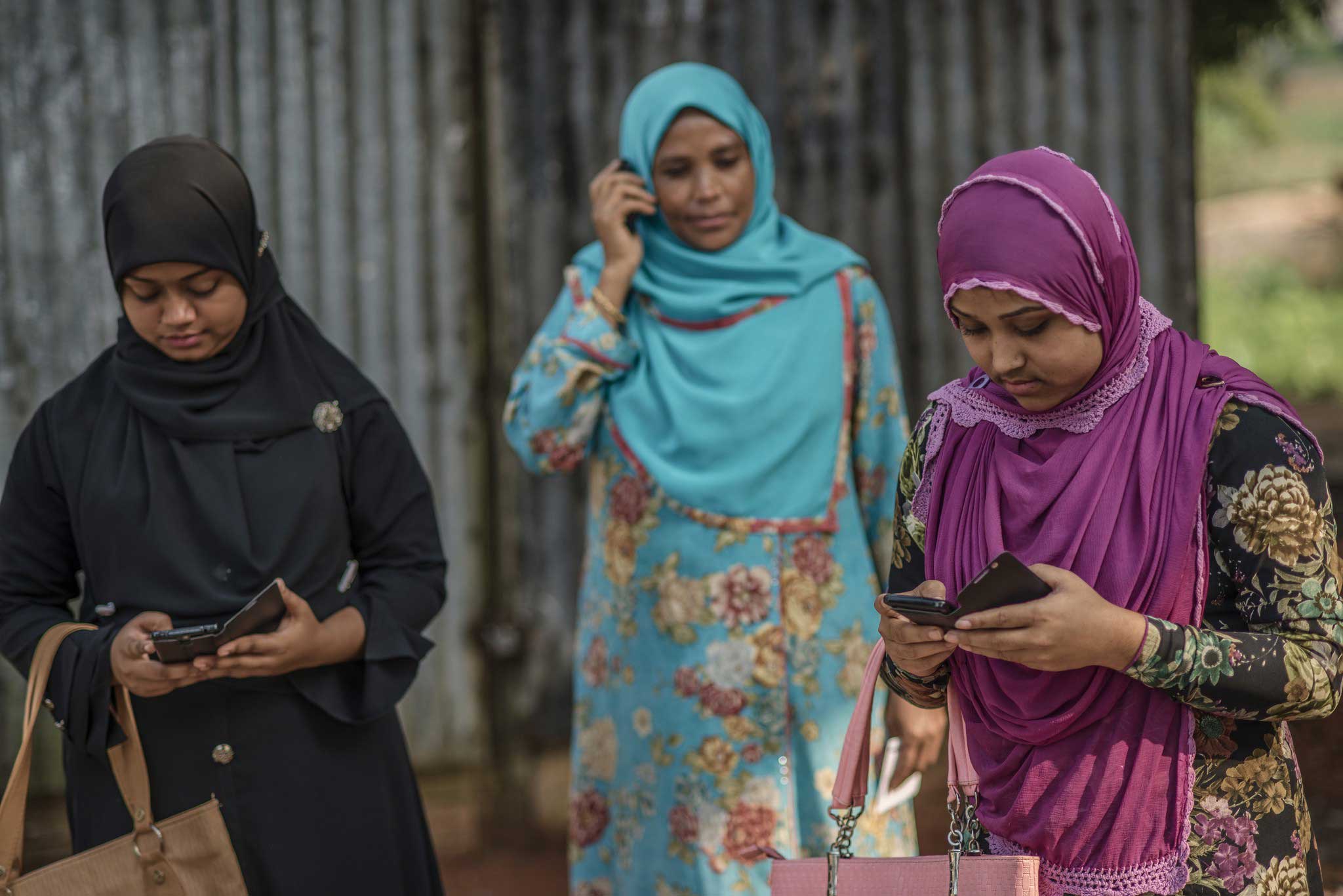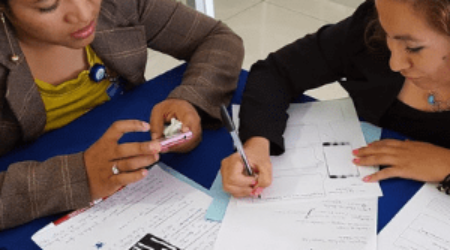Is Mobile Money Killing Off the Group Microfinance Model (And Would That Be Such a Bad Thing)?

In the summer of 2017, SAJIDA Foundation, an NGO and microfinance provider in Bangladesh, made a bold decision — it was going to make an entire branch of about 1,600 clients (or members, as SAJIDA calls them) cashless. Rather than attending group meetings to make microloan repayments in person, these members would show up at a mobile money (MM) agent and make their payments through a bill-pay option at a time and place convenient for them. Going cashless meant that in one fell swoop, digital financial services (DFS) would make group meetings, the locus of traditional microcredit for decades, redundant.
What follows is the story of redefining group meetings in a world of increasingly digitized microfinance, largely based on a renewed appreciation of the non-pecuniary roles these meetings perform. This is the first of a series of pieces in which BFA will track SAJIDA’s journey over the coming months as it digitizes its operations and goes cashless.
CASHLESS TRANSACTIONS ARE THE FUTURE …
In February 2017, SAJIDA started introducing digital loan disbursement and collection of installments at 15 branches through bKash, one of the major providers of MM in Bangladesh. This effort was driven by the reality that fewer and fewer members were coming to group meetings regularly because they were too busy. In 2016, we received this feedback from many SAJIDA field officers and confirmed this through a survey in which 87 percent of respondents reported that less than half the group attended meetings regularly. The same survey also found that only 7.7 percent of members looked forward to group meetings to talk to others, and only 3.9 percent socialized at these meetings, calling into question the widely assumed role of group meetings in generating social capital. The social role of groups seemed to have eroded. Simultaneously, MM had become ubiquitous as a convenient and time-saving payments solution. The time seemed ripe to try replacing cash handling at group meetings with MM-based transactions.
Soon after rolling out MM in early 2017, SAJIDA encountered several challenges. First, despite many improvements, members who were non-habitual MM users continued to point out pain points around opening accounts and needing to cash-in before making installment payments. Second, changes to MM regulations drastically lowered the balance and transactional caps of mobile wallets, making it impossible to disburse loans through wallets. Uptake of MM among its members was modest but not stellar, and it was evident to SAJIDA that more work was needed to smooth out the customer experience if MM was to work for the institution.
SAJIDA’s solution came through a partnership with Rocket, the digital financial services offering from Dutch-Bangla Bank Limited (DBBL), one of the major private banks in Bangladesh. DBBL had vastly increased its agent footprint and undertaken an extensive marketing campaign, and most importantly, it offered a bill-pay option. Unlike with bKash, SAJIDA members could show up at a Rocket agent and make installment payments without having to open an account.
While some have noted the downsides to such over-the-counter transactions, in this instance, the partnership with Rocket made a tangible difference in reducing friction in the MM customer experience. SAJIDA management also believed the partnership could deliver efficiency gains in the form of automated bookkeeping, reduced cash handling costs, and more time for loan officers to recruit and service loan recipients.
Based on these observations, SAJIDA decided to convert an entire branch to Rocket-based MM in June 2017. They bet that customers would find the MM experience to be so convenient, that after getting over the minimal initial learning curve, anyone would want to pay through Rocket rather than cash. They identified one of their older branches, Abdullahbag, as the pilot location for going cashless. It had an abundance of agents in close proximity to centers, and had other branches nearby should some members refuse to make the switch.
In many ways, SAJIDA’s bet seems to have paid off: In the eight months since going cashless, roughly 1,400 members have transacted digitally to the tune of US$100,000 per month. While there has been a slight reduction in the number of members, portfolio metrics (number of loans, outstanding amount, delinquency, etc.) have been indistinguishable from the typical month-to-month variations natural to microfinance.
More importantly, members love the ability to pay whenever and wherever — no more rushing to the group meetings for 30 minutes while food is cooking on the stove. There is also an element of pride in transacting with a bank (i.e., DBBL). Loan officers and accountants enjoy working with MM because they no longer have to endure the risk of carrying cash around. In addition, they no longer have to spend hours a day counting cash, so they can do other productive things. As an institution, SAJIDA values MM because digitization made their operations more efficient; overhead expenses associated with cash-handling, bookkeeping, monitoring and auditing can now be drastically reduced, and collection data is available in real time.
We at BFA are also pleased with the outcomes so far because, on top of all of these benefits, going cashless furthered one of the objectives of the OPTIX project — optimizing the way financial institutions offer products and services to their members.
… BUT IT’LL STILL TAKE A GROUP TO MAKE IT THERE

Nevertheless, there have been some downsides to the move. Group meetings (without joint liability) have been a key feature of traditional microfinance in Bangladesh, and from the start, both SAJIDA and BFA shared a certain uneasiness about doing away with them. While we were aware of academic and anecdotal evidence regarding potential negative impacts of eliminating group meetings, we were willing to do away with these weekly meetings in the spirit of experimentation, since their raison d’etre as a cash collection point no longer existed.
SAJIDA has monitored the impact of going cashless and group-less on its portfolio quality and staff-client dynamics to date. The feedback from the field officers (FOs) through conversation and surveys is as follows:
- FOs feel they are losing touch with members because of the lack of face-to-face contact.
- FOs find it harder to recruit members since one of the key mechanisms for recruiting new members was existing members bringing interested individuals to group meetings.
- It has become harder to solicit character references from group members, particularly long-standing ones, for larger loans.
- It is time-consuming for FOs to distribute account statements house-to-house, in lieu of writing in passbooks at meetings.
- The opportunity to inform members of changes in policy or new services from SAJIDA, and to share other important information has been drastically reduced.
- Attendance at group meetings (or lack thereof) and reports from other members would often serve as an early warning sign of a member intending to leave the area without settling their obligations — this channel of communication is gone.
- Meetings enabled a new FO to meet all group members at once, but now new FOs need individual introductions instead.
This increasing disconnect between FOs and members — and amongst members themselves — has been of great concern, and it has validated some of the initial apprehensions of SAJIDA’s leadership. Yet given the benefits noted earlier, especially for members who absolutely love the flexibility of being able to pay close to their home at any time of the day, it is clear that it makes no sense to turn back the clock and go back to cash.
So SAJIDA now faces a new question: Is there a way to preserve the utility of groups, without losing the efficiency gains from going cashless?
THE RISE OF CASHLESS GROUPS
After much soul-searching, internal discussions and weighing of all the evidence, SAJIDA has decided to reinstate group meetings on a monthly basis, to carry on its previous roles. But the following adjustments are being made to the cashless microcredit program:
- Group meetings will be reinstated once a month, instead of once a week, at the central location in the community, to preserve the human touch points that FOs feel are so critical to making microcredit work. During meetings, FOs will review SAJIDA’s products and services, and conduct various due diligence. And members can share their experiences with each other, particularly new members.
- Members will attend these meetings once a month, and receive their account statement directly from the FO. FOs will show up at the center location every week at a given time, just as before. These sessions will not be for organized meetings with the entire group, but will serve more as office hours for the FO. As a result:
- Members will know when and where to find the FO if they need him/her.
- FOs will be available to take care of all admission and loan disbursement-related paperwork.
- Any member who misses the monthly meeting will be able to collect their account statement during one of the subsequent three FO sessions.
- The location where center meetings are held will continue to be the focal point for recruiting members, and for introducing a new FO to existing members.
- Anchoring FOs to regular, weekly “office hour” sessions also makes sense from an organizational point of view.
- Preparing documentation and answering members’ questions are expected to take just 15–30 minutes, leaving plenty of time for outreach in the neighborhood.
- Because centers are spread out, these sessions will ensure the FO covers the entire area they are assigned, and not limit themselves to easy-to-reach areas.
Four additional branches went cashless on Dec. 1 of last year, with this altered group-based approach. The original Abdullahbag branch will also start phasing in this approach after sufficient outreach with members has been undertaken to convince them of the need to change their mode of interaction with SAJIDA again.
THE KEY TAKEAWAY
SAJIDA’s experience demonstrates the value of stress-testing to expose the weaknesses of an approach. This testing forced SAJIDA to innovate and find a space for cashless groups to provide the social interactions that make their group-based microfinance model work — and it did so before members were significantly inconvenienced, or significant damage happened to the branch’s portfolio.
This experience also provides another data point in the debate on the implications of digitizing microfinance. We offer this as the key takeaway: The value proposition for going cashless is clear for both financial institutions and their members, but there are risks to assuming that groups are disposable once their primary purpose of cash collection no longer exists. In situations like SAJIDA’s, the optimum combination involves both cashless transactions and cashless groups working in concert, complementing each other.



